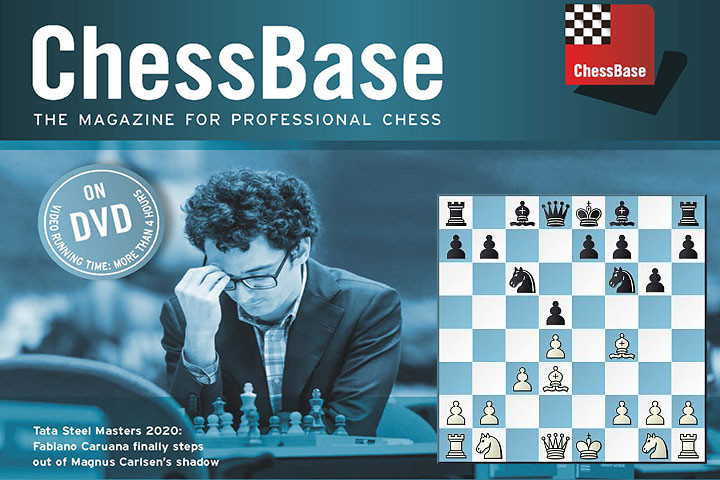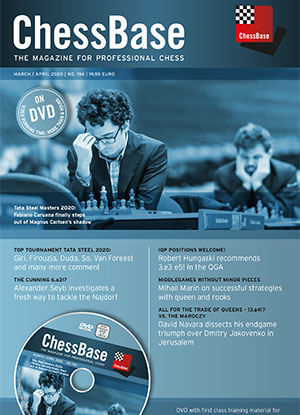


Nowadays it seems almost impossible to get an advantage from the opening against a well-prepared opponent. For that reason a great number of players are going back to systems in which understanding and experience (usually) have a greater role to play than purely opening-specific knowledge. Following this trend in recent years a variation against the Caro-Kann has become popular though it was once considered to be unambitious and not dangerous, namely 3.exd5 cxd5 4.Bd3 Nc6 5.c3.
But it has been shown that against the classic replies for Black 5...Qc7 (prevents Bf4) and 5...Nf6 followed by 6...Bg4 White can pose one unpleasant question or another and so up till now no totally convincing plan could be found (on this subject see also Igor Stohl's article "Is the Carlsbad structure reversed really so harmless?" from CBM 185). In the meantime there have even been very radical attempts to solve the problem in a super-concrete fashion after 5...Nf6 6.Bf4:
So I would like to take this opportunity to point out an under-estimated plan which brings a whole heap of advantages compared to the classic replies and which deserves to be tested more completely in practice. We are talking about the setup 5...Nf6 (or 5...g6) 6.Bf4 g6, followed by 7...Bf5, in order to swap off the active white bishop on d3.
In doing so I will show (almost) only variations in which the Ng8 is developed to f6. It is also, however, very interesting to at first delay ...Nf6 and to start with 5...g6, so as later, after the exchange on f5, to have the option of ...Nge7/Ng6.
Starting from the position in the diagram White more or less has two options: he either allows the exchange of bishops and accepts the structure after Bxf5 gxf5, or he chooses an avoidance strategy by means of 7.Qc2, in order to prevent Bf5 or after 7.h3 Bf5 8.Be2, both of which can be countered energetically.
The disadvantages of the 7.Qc2 variation can be traced very well in the game Zanan,E - Rahul,S 0-1, Gibraltar 2019, in which Black chooses a very powerful plan with ...Nh5,
followed by ...f6/...e5, in order to seize the centre for himself.
Against 7.h3 Bf5 8.Be2
the two Russians Girya and Riazantsev in their games Shuvalova,P - Girya,O 0-1, Izhevsk 2019 and Svidler,P - Riazantsev,A ½-½, Isle of Man 2019, chose a very compact setup with ...e6 and ...h5, which creates an impression of solidity and does not offer White any sort of point of attack to gain an advantage.
The most critical continuation is the structure after 7.Nf3 Bf5 8.Bxf5 gxf5.
With this transformation Black slightly weakens his pawn structure on the kingside, but obtains more influence on the centre, especially on the e4-square. In addition, later Black can possibly generate counterplay down the semi-open g-file. I advise against developing the Bf8 to g7, since from there it will be more or less biting on granite (b2/c3) and getting in the way of the rook on g8. With the bishop on g7 Black would probably have to castle short, which generally speaking I dislike because then one would not be able to really make any use of the advantages of the particular pawn structure.
To me the setup with ...e6, Bd6, Qc7, 0-0-0 and then Ne4 seems much sounder. A good initial impression for this is provided by the game Demchenko,A - Melkumyan,H 0-1, Riadh 2017.
Following on from the above, I would like talk a little about the most important motifs / themes:
1) The dream position Black is aiming for is: ...Bd6, ...Qc7, ...0-0-0, ...Ne4, ...Rhg8, ...h5 (...Kb8, ...Rc8).
2) The manoeuvres ...Nce7/Ng6 and ...Na5/Nc4 are very effective in the endgame.
3) In this particular Karlsbad structure too, another "dream square" for the knight is d6, from where it supports the minority attack (b5-a5-b4) and can at any moment pop up on e4 or c4.
4) ...Rg8-Rg4-Re4 can be particularly strong if White decides to change the structure with ...c4.
5) If after ...Rg8 White plays g3, it is worth considering resolving with h5-h4-hxg3 a potential weakness (the h-pawn).
6) f6/e5 is a very typical pawn thrust in the centre which can give Black the initiative.
7) If White opens the position with c4 before Black has managed to castle long, the black king can also find a good hiding place behind its pawn wall f7/e6/f5 on f8 or g8.
8) An early ...Rg8/...Nh5 (the Laznicka plan) forces White to play concretely.
9) Endgames are often good for Black on account of the flexibility which the central pawns bring.
10) Black need not fear further doubled pawns which could arise on the b-file after the exchange of queens, since after that he could exert pressure down the a-file and he has b4 as a pawn lever.
Furthermore, it neeeds to be considered which advantages and disadvantages arise if the knight which is posted on e5, usually a trump card for the white position, can be got rid of at some point in such a way that White is forced to recapture on e5 with the pawn, as in the game
Zuyev,I - Sumets,A ½-½, Heusenstamm 2018: 13...Bxe5!?
A very interesting idea for Black can be taken from two games by Viktor Laznicka (Ponizil,C - Laznicka,V ½-½, Pardubice 2016 and Rapport,R - Laznicka,V 0-1, Deizisau 2014), where he prefers to play an early ...Rg8 to provoke White into casting short and then continues with ...Nh5 to drive away the Bf4 and thus to obtain more influence over e5.
11...Nh5!? (Rapport,R - Laznicka,V 0-1)
Especially in the game against Rapport it becomes claer how much White must take care not to give up too much control of the centre since otherwise he is simply overrun.
But White too has some interesting plans. One is to exchange the Bf4 for the Nf6 to go on and play the position with two knights against a bishop and knight. Purely from the theoretical point of view this should not be a strategy which is particularly frightening, because all the black central pawns are on light squares (d5, e6, f7, f5) and thus the bishop has good control over the dark squares. Nevertheless Black must play precisely so as not to be overrun by plans such as Nb3-Nc5 and a queenside pawn storm. More detailed explanations of this line can be found in the game Larsen,K - Fier,A ½-½, Riga 2012.
In conclusion the advantages of this setup over the classical variations should be mentioned:
1) White does not have a simple standard plan, as is often the case in the classical variations.
2) The type of position is complex and slightly unusual.
3) The type of position has not yet been explored in depth and so offers more space for new creative ideas.
Conclusion: The plan with ...g6 and ...Bf5 against the Caro-Kann Exchange Variation offers players with Black the possibility to move on to terrain where plenty of interesting ideas are to be found. In my opinion Black shoud aim with , ...Bd6 and ...Qc7 for positions with queenside castling, but there are many other exciting setups, e.g. with ...Nge7-Ng6 and short castling. In any case the variation can be expected to grow in popularity since the classical replies are absolutely not completely satisfying.
You'll find the complete articles with all games and analyses by Roven Vogel in ChessBase Magazine #194!

Order now! Download or DVD...
ChessBase Magazine #194 (March/April 2020)
| Advertising |